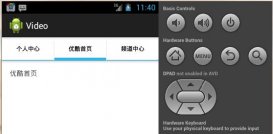方法一:
分析 mount 命令的返回信息,例如:
$ mount
rootfs / rootfs ro,relatime 0 0
tmpfs /dev tmpfs rw,nosuid,relatime,mode=755 0 0
devpts /dev/pts devpts rw,relatime,mode=600 0 0
proc /proc proc rw,relatime 0 0
sysfs /sys sysfs rw,relatime 0 0
debugfs /sys/kernel/debug debugfs rw,relatime 0 0
none /acct cgroup rw,relatime,cpuacct 0 0
tmpfs /mnt/asec tmpfs rw,relatime,mode=755,gid=1000 0 0
tmpfs /mnt/obb tmpfs rw,relatime,mode=755,gid=1000 0 0
none /dev/cpuctl cgroup rw,relatime,cpu 0 0
/dev/block/platform/sdhci-tegra.3/by-name/system /system ext4 ro,relatime,barrier=1,data=ordered 0 0
/dev/block/platform/sdhci-tegra.3/by-name/userdata /data ext4 rw,nosuid,nodev,noatime,barrier=1,data=ordered 0 0
/dev/block/platform/sdhci-tegra.3/by-name/cache /cache ext4 rw,nosuid,nodev,noatime,barrier=1,data=ordered 0 0
/dev/block/platform/sdhci-tegra.3/by-name/pdsb /pds ext2 ro,relatime 0 0
/dev/fuse /mnt/sdcard fuse rw,nosuid,nodev,relatime,user_id=1023,group_id=1023,default_permissions,allow_other 0 0
/dev/block/vold/179:9 /mnt/sdcard-ext vfat rw,dirsync,nosuid,nodev,noexec,relatime,uid=1000,gid=1015,fmask=0702,dmask=0702,allow_utime=0020,codepage=cp437,iocharset=iso8859-1,shortname=mixed,utf8,errors=remount-ro 0 0
/dev/block/vold/179:9 /mnt/secure/asec vfat rw,dirsync,nosuid,nodev,noexec,relatime,uid=1000,gid=1015,fmask=0702,dmask=0702,allow_utime=0020,codepage=cp437,iocharset=iso8859-1,shortname=mixed,utf8,errors=remount-ro 0 0
tmpfs /mnt/sdcard-ext/.android_secure tmpfs ro,relatime,size=0k,mode=000 0 0
Java 版代码如下:
// 给 C/C++ 编写的共享库回调取得全部 SD 卡路径的函数
public String
GetAllSDPath() throws TokenException
{
String strMountInfo = "";
// 1.首先获得系统已加载的文件系统信息
try
{
// 创建系统进程生成器对象
ProcessBuilder objProcessBuilder = new ProcessBuilder();
// 执行 mount -h 可以看到 mount : list mounted filesystems
// 这条命令可以列出已加载的文件系统
objProcessBuilder.command( "mount" ); // 新的操作系统程序和它的参数
// 设置错误输出都将与标准输出合并
objProcessBuilder.redirectErrorStream( true );
// 基于当前系统进程生成器的状态开始一个新进程,并返回进程实例
Process objProcess = objProcessBuilder.start();
// 阻塞线程至到本地操作系统程序执行结束,返回本地操作系统程序的返回值
objProcess.waitFor();
// 得到进程对象的输入流,它对于进程对象来说是已与本地操作系统程序的标准输出流(stdout)相连接的
InputStream objInputStream = objProcess.getInputStream();
byte[] buffer = new byte[1024];
// 读取 mount 命令程序返回的信息文本
while ( -1 != objInputStream.read( buffer ) )
{
strMountInfo = strMountInfo + new String( buffer );
}
// 关闭进程对象的输入流
objInputStream.close();
// 终止进程并释放与其相关的任何流
objProcess.destroy();
}
catch ( Exception e )
{
e.printStackTrace();
}
// 2.然后再在系统已加载的文件系统信息里查找 SD 卡路径
// mount 返回的已加载的文件系统信息是以一行一个信息的形式体现的,
// 所以先用换行符拆分字符串
String[] lines = strMountInfo.split( "\n" );
// 清空该字符串对象,下面将用它来装载真正有用的 SD 卡路径列表
strMountInfo = "";
for ( int i = 0;
i < lines.length;
i++ )
{
// 如果该行内有 /mnt/和 vfat 字符串,说明可能是内/外置 SD 卡的挂载路径
if ( -1 != lines[i].indexOf( " /mnt/" ) && // 前面要有空格,以防断章取义
-1 != lines[i].indexOf( " vfat " ) ) // 前后均有空格
{
// 再以空格分隔符拆分字符串
String[] blocks = lines[i].split( "\\s" ); // \\s 为空格字符
for ( int j = 0;
j < blocks.length;
j++ )
{
// 如果字符串中含有/mnt/字符串,说明可能是我们要找的 SD 卡挂载路径
if ( -1 != blocks[j].indexOf( "/mnt/" ) )
{
// 排除重复的路径
if ( -1 == strMountInfo.indexOf( blocks[j] ) )
{
// 用分号符(;)分隔 SD 卡路径列表,
strMountInfo += blocks[j] + ";";
}
}
}
}
}
return strMountInfo;
}
C 版代码如下:
char caStdOutLine[1024]; // mount 命令的标准输出中的一行信息
char* pcTmpSDPath = NULL;
// 再用 mount 命令获得的找身份认证锁
do // 非循环,只是为了方便控制分支层次,便于控制分支流向
{
// 通过创建一个管道,调用 fork 产生一个子进程,
// 执行一个 shell 以运行命令来开启一个进程。
// 这个进程必须由 pclose() 函数关闭。
FILE* fp = popen( "mount", // 一个指向以 NULL 结束的 shell 命令字符串的指针,
// 这行命令将被传到 bin/sh 并使用 -c 标志,
// 那么 shell 将执行这个命令从这个字符串中读取。
"r" ); // 文件指针连接到 shell 命令的标准输出
if ( NULL == fp )
{
break;
}
while( NULL != fgets( caStdOutLine,
sizeof( caStdOutLine ),
fp ) )
{
// 如果 找到了你想要的 SD 卡挂载路径 的话,则
if ( 判断条件 )
{
// 注:管道中的数据一定要读完,不然会崩溃掉的
continue; // 就不再试下一个挂载地址了
}
// 如果该行内有 /mnt/和 vfat 字符串,说明可能是内/外置 SD 卡的挂载路径
if ( NULL == strstr( caStdOutLine, " /mnt/" ) && // 前面要有空格,以防断章取义
NULL == strstr( caStdOutLine, " /storage/" ) ) // 前面要有空格,以防断章取义
{
continue; // 不满足条件说明这行不是内/外置 SD 卡的挂载路径
}
if ( NULL == strstr( caStdOutLine, " vfat " ) ) // 前后均有空格
{
continue; // 不满足条件说明这行不是内/外置 SD 卡的挂载路径
}
// 再以空格分隔符拆分字符串
pcTmpSDPath = strtok( caStdOutLine, " " );
do // 这里是循环,尝试每一个路径
{
if ( ( NULL == pcTmpSDPath ) ||
( '\0' == *pcTmpSDPath ) )
{
continue;
}
// 如果字符串中含有/mnt/字符串,说明可能是我们要找的 SD 卡挂载路径
if ( NULL == strstr( pcTmpSDPath, "/mnt/" ) &&
NULL == strstr( pcTmpSDPath, "/storage/" ) )
{
continue;
}
// TODO: 在此添加对 SD 卡路径使用的语句,如果只是用其中一个,别忘了设置已找到想要 SD 卡路径的标识
}while ( pcTmpSDPath = strtok( NULL, " " ) );
}
// 关闭标准 I/O 流,等待命令执行结束,然后返回 shell 的终止状态。
// 如果 shell 不能被执行,
// 则 pclose() 返回的终止状态与 shell 已执行 exit 一样。
pclose( fp );
}while ( 0 );
方法二:
分析 cat /system/etc/vold.fstab 命令的返回信息,例如:
$ cat /system/etc/vold.fstab
## Vold 2.0 fstab for Stingray
#######################
## Regular device mount
##
## Format: dev_mount <label> <mount_point> <part> <sysfs_path1...>
## label - Label for the volume
## mount_point - Where the volume will be mounted
## part - Partition # (1 based), or 'auto' for first usable partition.
## <sysfs_path> - List of sysfs paths to source devices
######################
# external sd card
dev_mount sdcard-ext /mnt/sdcard-ext auto /devices/platform/sdhci-tegra.2/mmc_host/mmc1 /devices/platform/sdhci-tegra.2/mmc_host/mmc2
# flash drive connection to USB1
dev_mount usbdisk_1.0 /mnt/usbdisk_1.0 auto /devices/platform/tegra-ehci.0/usb2/2-1/2-1:1.0
# flash drive connection through hub connected to USB1
dev_mount usbdisk_1.1 /mnt/usbdisk_1.1 auto /devices/platform/tegra-ehci.0/usb2/2-1/2-1.1
dev_mount usbdisk_1.2 /mnt/usbdisk_1.2 auto /devices/platform/tegra-ehci.0/usb2/2-1/2-1.2
dev_mount usbdisk_1.3 /mnt/usbdisk_1.3 auto /devices/platform/tegra-ehci.0/usb2/2-1/2-1.3
dev_mount usbdisk_1.4 /mnt/usbdisk_1.4 auto /devices/platform/tegra-ehci.0/usb2/2-1/2-1.4
dev_mount usbdisk_1.5 /mnt/usbdisk_1.5 auto /devices/platform/tegra-ehci.0/usb2/2-1/2-1.5
dev_mount usbdisk_1.6 /mnt/usbdisk_1.6 auto /devices/platform/tegra-ehci.0/usb2/2-1/2-1.6
dev_mount usbdisk_1.7 /mnt/usbdisk_1.7 auto /devices/platform/tegra-ehci.0/usb2/2-1/2-1.7
C 版代码如下:
char caStdOutLine[1024]; // cat 命令的标准输出中的一行信息
char* pcTmpSDPath = NULL;
char* pcNotSpace = NULL;
// 用 /system/etc/vold.fstab 获得的 SD 卡路径找身份认证锁
do // 非循环,只是为了方便控制分支层次,便于控制分支流向
{
// 通过创建一个管道,调用 fork 产生一个子进程,
// 执行一个 shell 以运行命令来开启一个进程。
// 这个进程必须由 pclose() 函数关闭。
FILE* fp = popen( "cat /system/etc/vold.fstab", // 一个指向以 NULL 结束的 shell 命令字符串的指针,
// 这行命令将被传到 bin/sh 并使用 -c 标志,
// 那么 shell 将执行这个命令从这个字符串中读取。
"r" ); // 文件指针连接到 shell 命令的标准输出
if ( NULL == fp )
{
break;
}
while( NULL != fgets( caStdOutLine,
sizeof( caStdOutLine ),
fp ) )
{
// 如果 找到了你想要的 SD 卡挂载路径 的话,则
if ( 判断条件 )
{
// 注:管道中的数据一定要读完,不然会崩溃掉的
continue; // 就不再试下一个挂载地址了
}
// Format: dev_mount <label> <mount_point> <part> <sysfs_path1...>
// 去除开头的空格
pcNotSpace = caStdOutLine + strspn( caStdOutLine, " " );
if ( NULL == pcNotSpace ||
'\0' == *pcNotSpace ||
'#' == *pcNotSpace || // 行首字符为#说明是注释行
'd' != pcNotSpace[0] || // 句子开头不是 dev_mount
'e' != pcNotSpace[1] ||
'v' != pcNotSpace[2] ||
'_' != pcNotSpace[3] ||
'm' != pcNotSpace[4] ||
'o' != pcNotSpace[5] ||
'u' != pcNotSpace[6] ||
'n' != pcNotSpace[7] ||
't' != pcNotSpace[8] )
{
continue; // 不满足条件说明这行不是内/外置 SD 卡的挂载路径
}
// 再以空格分隔符拆分字符串
pcTmpSDPath = strtok( pcNotSpace, " " );
do // 这里是循环,尝试每一个路径
{
if ( ( NULL == pcTmpSDPath ) ||
( '\0' == *pcTmpSDPath ) )
{
continue;
}
// 如果字符串中含有/mnt/字符串,说明可能是我们要找的 SD 卡挂载路径
if ( NULL == strstr( pcTmpSDPath, "/mnt/" ) &&
NULL == strstr( pcTmpSDPath, "/storage/" ) )
{
continue;
}
// TODO: 在此添加对 SD 卡路径使用的语句,如果只是用其中一个,别忘了设置已找到想要 SD 卡路径的标识
}while ( pcTmpSDPath = strtok( NULL, " " ) );
}
// 关闭标准 I/O 流,等待命令执行结束,然后返回 shell 的终止状态。
// 如果 shell 不能被执行,
// 则 pclose() 返回的终止状态与 shell 已执行 exit 一样。
pclose( fp );
}while ( 0 );














